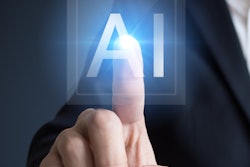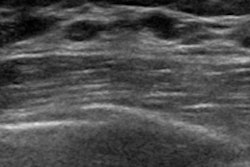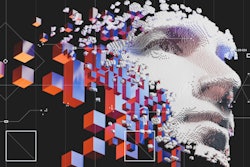
Our journey on the Road to RSNA continues with a look at artificial intelligence (AI) topics and issues in subspecialty areas such as breast imaging, emergency radiology, neuroradiology, pediatric radiology, interventional radiology, and physics. (We previously discussed AI in radiology informatics.)
Breast imaging
AI is going to again dominate the breast imaging program at RSNA this year, according to Dr. Fiona Gilbert, chair of the RSNA Scientific Program Committee's subcommittee for breast imaging and head of radiology at the University of Cambridge School of Medicine in the U.K.
 Dr. Fiona Gilbert.
Dr. Fiona Gilbert.Research will again be presented on the use of AI in conventional mammography, but these studies will include data from a much larger number of patients, she said. In addition, there will be developments involving AI in breast ultrasound as well as MRI.
AI holds a lot of potential in breast imaging applications such as triaging screening mammography cases with the greatest likelihood of having a cancer, providing computer-aided detection marks on images for radiologists, and helping radiologists to lower recall rates, according to Gilbert. Digital breast tomosynthesis will also be an important area for AI.
As for other modalities, Gilbert noted that whole-breast ultrasound is currently a time-consuming exam for the radiologist to scroll through all the images.
"To have really good AI detection tools for ultrasound would be fantastic," she said. "They're being developed, so we're hoping they're going to become available shortly. That will really help us."
AI tools are also being developed for breast MRI, often involving the use of radiomics, she said.
"There's a lot happening [for AI] in the space of breast imaging, which is great," Gilbert said.
Looking to the future, Gilbert would like to see more prospective research studies assessing AI in breast imaging.
"It's essential that we do some prospective studies to look and see what the real impact of AI is going to be on the radiological practice," she said.
Emergency radiology
AI has become a larger component of the submissions in emergency radiology over the past few years, said Dr. Ferco Berger, chair of the RSNA's emergency radiology subcommittee and head of emergency and trauma radiology at Sunnybrook Health Sciences Centre in Toronto.
 Dr. Ferco Berger.
Dr. Ferco Berger."In general, they still focus very much on the detection of one entity, and a fair bit of that is in trauma," he said. "The single most diagnosis that I see abstracts for is for rib fracture detection, both on x-rays and CT. But there are definitely also some other ones, like intracranial hemorrhage detection or volume assessment of hemoperitoneum after trauma or free air in the abdomen either related to trauma or to nontraumatic emergencies in the abdomen."
AI also has some emergency chest applications, such as detecting pneumothorax and pulmonary emboli, as well as identifying incidental nodules found during emergency imaging, he said. In addition, a few COVID-19-related submissions explored the use of AI for quantifying the extent of COVID-19 changes in the lung and what it means for patient prognosis.
Current AI work in emergency radiology focuses mostly on study prioritization, identifying cases that radiologists should pay urgent attention to and bumping them up on the worklist, as well as reducing reading times, he said.
Neuroradiology
 Dr. Max Wintermark.
Dr. Max Wintermark.Once again, many AI abstracts were submitted in neuroradiology, spanning a wide range of applications, including efforts aimed at improving image acquisition speed and quality, quantification (segmentation), and interpretation, said Dr. Max Wintermark, chair of the RSNA's neuroradiology/head and neck subcommittee and chief of neuroradiology at Stanford University.
Many of these studies involved MRI, but a few addressed CT, he said. As for clinical applications, stroke was well represented, along with brain tumors and dementia. It's difficult to predict where AI is going to go, however, and clinical adoption remains the main challenge, according to Wintermark.
"Right now, we have interesting research projects and the transition to the routine clinical practice still needs to happen," Wintermark said. "There are a few examples where this transition has happened, including some applications for stroke and multiple sclerosis. This is encouraging for the future. [However,] several important issues will need to be addressed, including very important ethical issues, for instance related to the diversity of the data."
Pediatric radiology
More papers on AI topics will be presented this year in pediatric radiology at the RSNA meeting, according to Dr. Lynn Fordham, subcommittee chair for pediatric radiology.
 Dr. Lynn Fordham.
Dr. Lynn Fordham.AI tools show a lot of potential in pediatric radiology. For example, algorithms that can identify exams with significant pathology -- such as intracranial hemorrhage -- and elevate those studies to the top of a worklist can really improve workflow and patient care, said Fordham, a professor of radiology and division chief of pediatric imaging at the University of North Carolina. In addition, applications that can rapidly measure a region of interest can also enhance the workflow and quality of work for radiologists.
"I like to think about differentials, and I like to think about the imaging manifestations of things, but I don't really have a lot of fun actually getting out my little calipers and measuring things," she said. "So AI tools that can measure things and can, in general, make the radiologist more able to spend time on high-yield things, like talking with patients about their results or spending extra time with a pediatric patient for a patient exam -- that's a much better way for me to spend my time."
Interventional radiology
 Dr. Ronald Arellano.
Dr. Ronald Arellano.In interventional radiology applications for AI, there's a trend among scientific papers at RSNA 2020 toward exploring the utility of AI for predicting treatment outcomes based on image analysis, according to Dr. Ronald Arellano, chair of the RSNA's vascular and interventional subcommittee and an associate professor of radiology at Massachusetts General Hospital.
For interventional radiologists, AI could wind up essentially as an equivalent of another lab test -- an additional set of data to help guide their clinical judgement, Arellano said.
"If we subject patients' imaging to an AI analysis and we get out a number or an analysis, we will then factor that into our decision-making, into our patient counseling, into our expectations of a treatment," Arellano said. "I see AI having that kind of a role in interventional radiology."
Physics
 Jerome Liang, PhD.
Jerome Liang, PhD.AI is a dominant topic among the physics papers being presented at RSNA 2020. These efforts have been driven largely by advances in computing power in recent years, said Jerome Liang, PhD, chair of the physics subcommittee and a professor of radiology, physics and astronomy, electrical and computer engineering, computer science, and biomedical engineering at Stony Brook University Hospital in Stony Brook, NY.
Specific AI applications in physics research include applying the technology for image reconstruction in MRI, as well as to a lesser extent in CT, Liang said.
"AI has most relevance in MRI because of the type of data that can be had," Liang said. "We're starting to see that AI can do a good job for image reconstruction in MRI. A similar trend would be seen for low-dose CT reconstruction, as well as spectral CT."
AI will also be discussed in a variety of applications to assist in image-based diagnosis, he said.




















